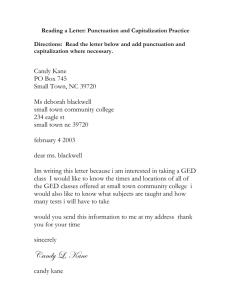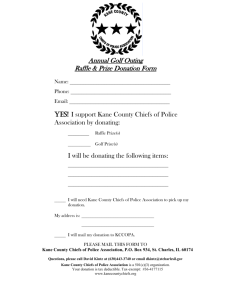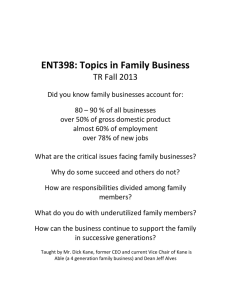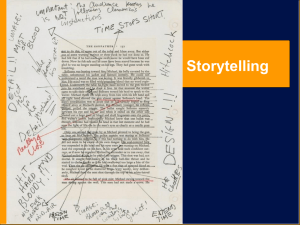21l.011-kane-rewrite..
advertisement
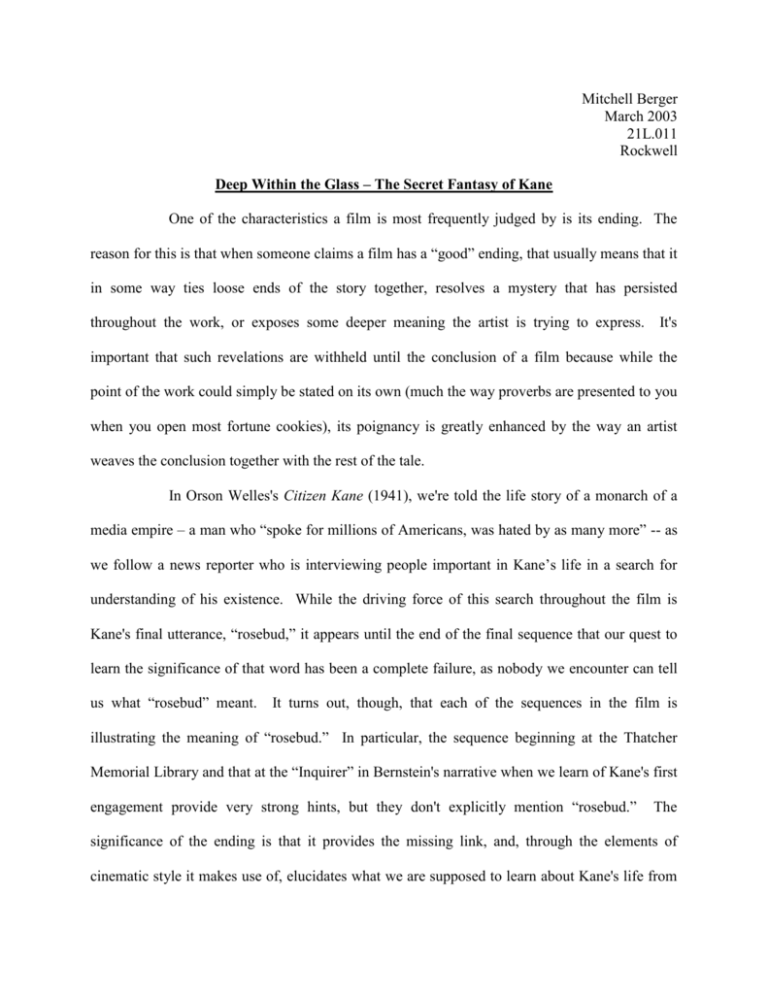
Mitchell Berger March 2003 21L.011 Rockwell Deep Within the Glass – The Secret Fantasy of Kane One of the characteristics a film is most frequently judged by is its ending. The reason for this is that when someone claims a film has a “good” ending, that usually means that it in some way ties loose ends of the story together, resolves a mystery that has persisted throughout the work, or exposes some deeper meaning the artist is trying to express. It's important that such revelations are withheld until the conclusion of a film because while the point of the work could simply be stated on its own (much the way proverbs are presented to you when you open most fortune cookies), its poignancy is greatly enhanced by the way an artist weaves the conclusion together with the rest of the tale. In Orson Welles's Citizen Kane (1941), we're told the life story of a monarch of a media empire – a man who “spoke for millions of Americans, was hated by as many more” -- as we follow a news reporter who is interviewing people important in Kane’s life in a search for understanding of his existence. While the driving force of this search throughout the film is Kane's final utterance, “rosebud,” it appears until the end of the final sequence that our quest to learn the significance of that word has been a complete failure, as nobody we encounter can tell us what “rosebud” meant. It turns out, though, that each of the sequences in the film is illustrating the meaning of “rosebud.” In particular, the sequence beginning at the Thatcher Memorial Library and that at the “Inquirer” in Bernstein's narrative when we learn of Kane's first engagement provide very strong hints, but they don't explicitly mention “rosebud.” The significance of the ending is that it provides the missing link, and, through the elements of cinematic style it makes use of, elucidates what we are supposed to learn about Kane's life from Mitchell Berger March 2003 21L.011 Rockwell all we've been told by his acquaintances. The Thatcher Memorial Library is a dark place, and when the reporter, Thompson, approaches the reading chamber, the use of deep focus suggests to us that while action (discussion with the receptionist) is taking place in the foreground, important meaning is to be found in the background (inside the chamber containing Thatcher’s memoirs). Once inside, we find that the room is very dimly lit, and in fact, there's only one broad ray of light, and it is focused on the edge of the table where Thatcher's memoirs are placed. We later find out that in being allowed to read from this book, Thompson “has enjoyed a rare privilege” -- he's been allowed a glimpse through a narrow window into a world known to very few. Indeed it is a view of Kane's secret world that we are seeking. When his time concludes, the receptionist inquires whether he's found what he was looking for, and he indicates that he hasn't, unless her name happens to be Rosebud. The use of overall dim lighting in the room with one beam of light on the memoirs is a strong hint that examining them closely could have been fruitful because they contain the information Thompson has been looking for. That, combined with mention of his rare privilege (which suggests that the reason nobody else seems to know what “rosebud” means may simply be that they haven’t looked in the right place), and the shallowness of his closing exchange with the staff are indications that he has simply missed the point despite that the information he sought was in fact contained within the pages he was reading. During most of the narrative told by the memoirs, the deep focus technique is again utilized to hint to us that while Kane's mother is busy signing away his life to Thatcher in the foreground, and while his father is busy arguing about this decision as he wavers between the Mitchell Berger March 2003 21L.011 Rockwell foreground and middleground, there's some very important meaning to be understood about the background, which is where Kane himself is playing in the snow, as yet unaware of what's taking place inside the house. Whereas the book of memoirs was a figurative window into a world most people don't know about, the boarding house features a literal window into the far frame. In that far frame is Kane's secret world which he's involuntarily plucked from. After having finally heard the legalese in the contract Mrs. Kane signs, the feelings of the child whose guardianship has just been transferred are finally exposed without pretense. Outside in the snow, in a shot uncomplicated by hidden meanings found with deep focus, he immediately displays both an unwillingness to go on the trip without his mother, and a disdain for Thatcher and the impending change he represents to Kane's life. The strength of these feelings is demonstrated through an attack on Thatcher made with the all-important sled. Despite his objections, Kane is removed from this carefree world he so desperately wants to remain a child in. At this point, his reasons for resisting the change in his life obviously aren’t based on analysis of the way his resultant future will differ from the one he would otherwise have, but just the same he seems to know that this is not what’s right for him. In contrast, when we find ourselves at the offices of “The Inquirer” during Bernstein's narrative, we notice a scene that is much less cinematically complex than we had seen at Mrs. Kane's boarding house. The lack of deep focus and the lack of much audible action offscreen indicate that all the meaning we're intended to derive is right in front of us. What's apparent is that Kane has been collecting statues from all over Europe, and that this is a behavior that's new to him (at the gala dinner affair, Kane mentioned that he had only been buying for a Mitchell Berger March 2003 21L.011 Rockwell few months, and it was also suggested that the new staffers might change Kane). Artwork often depicts fantasy worlds, and statues are a three-dimensional form of artwork intended to be lifelike and allow one to construct his own scene. Leland expresses mixed feelings of excitement and frustration that he doesn't know what to do with all the statues as the collection seems to be growing without bound. Kane, now with the means to do so, is trying to gather enough artwork to make himself happy by constructing a fantasy world, but his search for the right characters to build it out of seems insatiable. Next, Kane himself appears with the announcement of his engagement to Ms. Norton (the other collectible spoken of by Bernstein). Though the “Inquirer” staffers appear thrilled to see him, and attempt to present him with a trophy bowl to welcome him home, Kane's demeanor betrays that something important is amiss. He behaves very awkwardly, appears to feel out of place, and ends up running away from the office to flee with his new fiance. The immediately obvious and shallow interpretation is that Kane isn't comfortable around his old newspaper acquaintances anymore now that he's beginning his new life with Norton. While that might be true, a more symbolic reading points out that there were two worlds in the shot while he was in the office: his fantasy world in the making with all the statues, and the real world with Leland, Bernstein, and the other animate characters. We already know that Kane had, as a child, been removed from the world he wanted to be a part of, and that having aged, he could never go back to it. A yearning to try to return to that world may have been what drove him to attempt to construct a fantasy world. It was, however, not real, and the awkwardness seen in Kane's behavior when he entered the office, which appeared to come as a Mitchell Berger March 2003 21L.011 Rockwell shock to him, may have been due to the overlaying of reality with that world (in the same way that juxtaposition can show us a connection between two seemingly independent things, overlaying them in the same space can make the point even more forcefully). The two worlds don't coexist well, and while Kane might have wanted to be part of the fantasy, he in fact was part of reality. Of course, while the arguments made so far may well seem plausible to someone who has seen all but the ending sequence of the film, it's far less likely that these ideas would occur to that person. At the conclusion, Raymond tells his tale at Xanadu, which itself is a fantasy world constructed by Kane – a fact that was pointed out to us in the “News on the March” segment that opened the story. When Kane's rampage finally ends, he is pensively holding a snow globe. These cute little objects we can buy at gift shops depict inanimate winter fantasy scenes, and highlight the fact that there's a barrier between fantasy and reality; the glass prevents reality from getting in and fantasy from getting out. As he walks down the hall with the globe, once again deep focus is used, and when he enters the far frame with the globe, just as he had been in the far frame during Thatcher's narrative, there is a strong hint that he's holding the secret we've been looking for all along in that globe. Its connection to him is reaffirmed by the shot where he passes by several mirrors that reflect him back and forth, and it's a visual hint that he is reflecting upon himself during his final walk. He finally does break the barrier between the two worlds, when he drops the globe and shatters the glass, but as he may have first suspected upon his return to “The Inquirer” offices, he doesn't succeed in bringing the worlds into coexistence; the fantasy world is ruined, reality persists, and Kane is dead. Mitchell Berger March 2003 21L.011 Rockwell As we leave Xanadu, we pass through the great mass of statues and other artifacts of a fantasy world (jigsaw puzzles included, as Alexander used them to construct scenes of worlds she may have wished to be a part of) that had been accumulated, and it is reminiscent of the scene at the newspaper's offices. Finally, we see the sled with Kane's final word, “Rosebud” on it, and we remember the scene in the snow where Kane pushed Thatcher to the ground with a sled as a protest against being taken away from his carefree world. This ending sequence isn't special because of new meaning to be found in it; likely just seeing the mounds of statues and a sled with the name “Rosebud” on it would be unrevealing on its own. The truth is that we've learned the secret about Kane already, several times over, and it's the cinematic elements such as deep focus and overlaying reality with fantasy, which when used together allow us to make the connection between the various narratives that came before, and showing us the sled with the word “Rosebud” finally tells us why Kane summed up his troubles with that word alone. As if to guard against the possibility that the point had not been made with enough impact, when the sled enters the furnace, we first see the word “rosebud” melt and fade away because of the heat, and then the sled ends up in flames. Just as the turning over of Kane to Thatcher was an irreversible action which made Kane’s return to his carefree childhood impossible, the combustion of the sled is an irreversible action and the sled can never be recovered.
